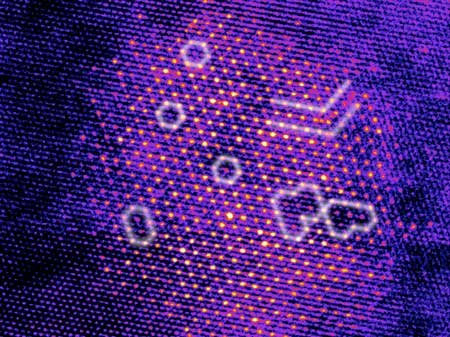| Nov 13, 2018 | |
Optimization of alloy materials: Diffusion processes in nanoparticles decoded(Nanowerk News) Aluminium alloys have unique material properties and are indispensable materials in aircraft manufacturing and space technology. With the help of high-resolution electron tomography, researchers at TU Graz have for the first time been able to decode mechanisms crucial for understanding these properties. The research results have recently been published in Nature Materials ("Diffusion-defining atomic-scale spinodal decomposition within nanoprecipitates"). |
|
 |
|
| Electron microscopic image of an aluminium nano-precipitate with atom-sized diffusion channels. (Image: TU Graz / FELMI) | |
Nano structures responsible for material quality |
|
| Alloy elements such as scandium and zircon are added to the aluminium matrix to improve the strength, corrosion resistance and weldability of aluminium alloys. After further treatment, tiny roundish particles only a few nanometres in size, so-called nano-precipitates, are formed. Their form, atomic structure and the ‘struggle’ of the scandium and zircon atoms for the ‘best place’ in the crystal lattice are decisive for the properties and usability of the material. | |
| Researchers at TU Graz analysed these structures with the help of the Austrian Scanning Transmission Electron Microscope (ASTEM) at the Graz Centre for Electron Microscopy (ZFE). The device can produce high-resolution element mappings of three-dimensional structures. | |
| ‘The thus arrived at tomographic analysis provided an image which, surprisingly, could not be interpreted according to the previous level of knowledge,’ said Gerald Kothleitner, head of the working group for analytic transmission electron microscopy at the TU Graz’s Institute of Electron Microscopy and Nanoanalysis. ‘We detected anomalies in the generated core-shell structures. On the one hand, we found higher quantities of aluminium in the nano-precipitates then we had presumed. On the other hand, we discovered a zircon-enriched core as well as border zones between the core and shell with an almost perfect composition and crystal structure.’ | |
Quantum mechanics and Monte Carlo methods provide answers |
|
| To track down this phenomenon of self-organisation, researchers from the Institute of Electron Microscopy and Nanoanalysis (FELMI) and the Institute of Materials Science, Joining and Forming (IMAT) fell back on quantum mechanical calculations and simulations. It was found that the system separates itself and forms atomically narrow channels in which the foreign atoms can diffuse. Atoms encountering each other block these channels and stabilise the system. | |
| Doctoral student Angelina Orthacker, whose thesis was funded by the Austrian Cooperative Research (ACR), gives a graphic explanation of the movement of the atoms: ‘The diffusion process can be compared with the formation of an emergency corridor in an urban area with heavy traffic. The traffic manages to organise itself in a split second to enable the free flow of emergency vehicles. But it only takes a few individual vehicles to block the emergency corridor thus stopping it from working.’ | |
| And this is exactly the same behaviour in the interior of aluminium alloys. ‘Emergency corridors’ promote the material transport of scandium and zircon atoms and even slight disturbances stop this transport reaction. | |
| The research team presumes that the new findings about these diffusion processes also play a role in other multi-component alloys. Their properties can now be adjusted even more. |
| Source: TU Graz | |
|
Subscribe to a free copy of one of our daily Nanowerk Newsletter Email Digests with a compilation of all of the day's news. |
